
If you’re wondering “Where is the spark plug on a lawn mower?”, it’s likely your machine has broken and you’ve got an overgrown lawn waiting to be cut. Even worse, maybe it stopped working mid-trim, leaving your grass half-mown.
Repairing your lawn mower isn’t just about getting your garden looking neat and tidy. It’s also a great way to save time and money, because you won’t have to research the best lawn mowers or best riding lawn mowers and splash out on a new model. Mending a damaged machine will also help save a repairable tool from going to waste, which is better for the planet.
Even without a breakdown, experts recommend that you regularly check and clean the spark plug, replacing it each year to ensure your mower always starts reliably – so keep reading to find out how.
What is the spark plug?
The spark plug provides the ignition source for a gas-powered lawn mower engine. It sends an electrical current to the combustion chamber which holds the compressed fuel. This current ignites the fuel, triggering combustion and firing up the engine. If you drive a gasoline vehicle, it will also have a spark plug, as spark plugs are an essential component of a traditional combustion engine. While we recommend seeking help from a mechanic if your car or truck needs a new spark plug, replacing this part on a lawn mower is a relatively easy job you can do at home.
On most of the best lawn mowers (such as walk-behind models), the spark plug is typically located near the front of the engine. Spark plugs are usually concealed behind a rubber cap, which protects the part from dust and debris, including stray grass cuttings. This is connected to a short wire, about a quarter-inch thick. It should be easy to find the spark plug on your mower once you have disconnected this wire, which you can do by hand.
On the best riding mowers, the spark plug is also located near the front of the engine, underneath the hood. You will probably need to unscrew and remove the engine cover to access the spark plug. Once uncovered, you’ll see that the spark plug is near the front of the engine, covered by a cap and connected to a short wire, just like on a push mower.
If you’re unsure, check the owner’s manual to see where is the spark plug on a lawn mower from a specific manufacturer.
Signs of a failing spark plug
Tom Monson, CEO of Monson Lawn & Landscaping, says, “A failing spark plug can cause a variety of problems with the mower, such as difficulty starting it or a decrease in engine performance”. If you experience any of the following, it might be a sign that your mower’s spark plug is dirty or damaged, which could cause it to fail;
• Trouble starting the engine. The most common sign of a faulty spark plug is difficulty starting the mower’s engine. If using a push mower, you might find you’re having to pull the starter rope more times to get it going. On a riding mower, you may notice that the engine doesn’t start reliably when you turn the key.
• Using more fuel. A faulty spark plug could be the reason you are refilling your lawn mower’s gasoline tank more frequently. If the plug isn’t sparking properly, the fuel won’t burn as fully or as efficiently, which can increase your mower’s fuel consumption. You might also notice an odor of gasoline when using the mower caused by the fuel not fully burning.
• Engine cutting out. If the engine cuts out immediately after starting, or runs for a while then stops (leaving you with a half-mowed lawn), the spark plug could be the culprit. You might also notice the engine sputtering or popping.
• Visible damage. If you examine the spark plug and spot any signs of damage, it will need replacing.

How to check spark plugs
After locating the spark plug on your mower, you need to remove it to check it. Bryan Clayton, CEO and co-founder of GreenPal, says, “Pull off the wire that goes to the top of the spark plug and use a spark plug wrench to take it out. Then you can look at the tip of it and see if it's dirty or burnt. If it is, you need to clean it or replace it.”
Other common indicators of wear and tear can include a center electrode with a rounded top (this should be flat), cracks in the porcelain sheath that protects the spark plug, or pitting on the firing electrode. A spark plug that’s in good condition will be a light gray or tan color. If the spark plug is covered in black carbon residue or wet from gasoline, it will need a thorough clean.
How to clean spark plugs
Lawn mower spark plugs are inexpensive to buy, so you might find it’s easier to simply replace a dirty spark plug rather than cleaning it. Spark plugs are also readily available from hardware stores or online retailers, which means you won’t have to search too hard to find a replacement.
However, if you need to use your mower and can’t get to the store or wait for a new spark plug to be delivered, it’s possible to clean the existing spark plug. Perhaps you also want to avoid buying new parts when it’s not entirely necessary, to help reduce waste and save money. Either way, it’s easy to clean spark plugs in a few simple steps;
1. Detach the spark plug
Remove the spark plug from the mower.
2. Use rubbing alcohol to cut the grease
Dip the tip of the plug in rubbing alcohol to cut through any oily residue. You can also use a brake cleaner or degreaser.
3. Clean the spark plug
Scrub the spark plug clean using a wire brush.
4. Give it a rinse
Rinse with rubbing alcohol or your chosen cleaning product.
5. Dry it off
Scrub again if required, then dry the spark plug.
6. Repeat as necessary
If the spark plug is still dirty, repeat the process until clean.
Keep in mind that cleaning the spark plug may not fix it, as the fault may be electrical. If you refit the clean spark plug and the lawn mower engine still won’t start or continues cutting out, you will probably need to replace the spark plug.
How to replace spark plugs
Before replacing your mower’s spark plug, you’ll need to work out which one to buy. Bryan Clayton says, “You need to get a new one that's the same as your old one. You can write down the code on your old one, check your manual, or take it with you when you go to buy a new one.” As he explains, most spark plugs have a code on the side which makes it simpler to track down the correct replacement. Most manufacturers produce spark plugs that can be used across mower brands, but if you are unsure, consult the owner’s manual.
Whether you have a walk-behind or ride-on mower, fitting a new spark plug should be quick and simple;
1. Use anti-seize grease
Before inserting the new spark plug, apply a very small amount of anti-seize grease (available from hardware stores). This should ensure the spark plug is easier to remove in the future.
2. Attach the spark plug
Use your fingers to thread the spark plug into place.
3. Make sure it's tight
For a secure fit, tighten the spark plug another half or three-quarters turn using a spark plug wrench.







